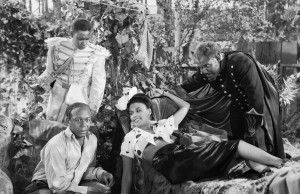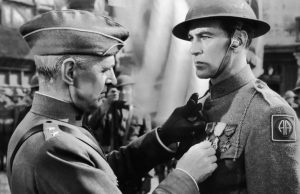The Member of the Wedding (1952)

Toronto Film Society presented The Member of the Wedding (1952) on Monday, May 2, 1977 in a double bill with Professional Sweetheart as part of the Season 29 Monday Evening Film Buff Series, Programme 9.
Production Company: Stanley Kramer Company. Associate Producers: Edna and Edward Anhalt. Director: Fred Zinnemann. Screenplay: Edna and Edward Anhalt, based on the book and play by Carson McCullers. Photography: Hal Mohr. Editorial Supervision: Harry Gerstad. Editor: William Lyon. Art Director: Cary Odell. Music: Alex North.
Cast: Julie Harris (Frankie Addams), Ethel Waters (Bernice Sadie Brown), Brandon de Wilde (John Henry), Arthur Franz (Jarvis), Nancy Gates (Janice), William Hansen (Mr. Addams), James Edwards (Honey Camden Brown), Harry Bolden (T.T. Williams), Dick[ie] Moore (Soldier), Charlcie Garrett (Aunt Pet), Danny Mmmert (Barney Mackean), June Hedin (Helen), Ann Carter (Doris).
The Member of the Wedding is one of the neglected minor masterpieces of the American Cinema. A work of delicate subtlety, it was unsuccessful in its first commercial run and is seldom revived to this day, though many viewers are charmed by the work on those rare occasions when it is revived. With the exception of Pauline Kael, who has praised the movie enthusiastically, most critics have ignored it, or have dismissed it as mere canned theatre, since the script is virtually a transcription of the stage play.
Frankie, the novel’s 12 year old Southern girl heroine, on the verge of adolescence and beginning to feel the need of some form of emotional involvement, “falls in love” with the idea of her brother’s wedding: in finding herself rebuffed at a time she feels she has most to give to those she loves–her brother, quite naturally, refuses to let Frankie accompany him on his honeymoon–and through a subsequent more violent contact with grown-up values, Frankie’s childhood is dramatically ended.
The Member of the Wedding doesn’t deal with literal imprisonment although as the characters begin to feel more confined psychologically, the action moves to constricting interior sets from its opening exterior scene. Rather, it deals with various forms of symbolic entrapment. The middle-aged maid, Bernice and the other black characters are trapped by their race. Frankie, the main character, is trapped by her age. A precocious twelve-year-old, she’s neither a child, like her seven year-old cousin John Henry, nor an adult, like her older brother Jarvis. She’s not even an adolescent yet.
All three versions of the story, novel, play, and film, preserve the themes of entrapment, loneliness, and frustration, and in ways that are totally organic to each medium. Each version has a three-part structure, though this is less evident in the movie than in the novel and stage play. Part one in each form deals with Frankie’s restless dissatisfaction with her life, her sense of purposelessness. She doesn’t seem to “belong” to anyone or anything: her mother died when she was born, her father is busy with his work, her brother Jarvis is in the army and away from home, and Bernice goes to her own home each night. Part two deals with her romantic infatuation with her bother’s wedding. She decides that after Janice and Jarvis get married she will go with the couple and join them in what she imagines will be a life of constant excitement and glamour. The third part of the story deals with her bitter disillusionment when she is not allowed to be a “member” of the wedding, and she believes that she will remain “captured” in the same town and house with the same tiresome companions. Each version of the story ends with a scene of reconciliation that takes place several months after the main action. Frankie is somewhat wiser now, and because she has found new friends her own age, her prospects for the future seem more promising.
The writing and acting in The Member of the Wedding are so fine that it would be artistically criminal to drown them with “cinematic” trumperies. Frankie in love with language and though she is often ungrammatical, she’s fond of punctuating her talk with precocious “literary” affectations, like “I am sick unto death…” and “It was one of the ironies of Fate…” and “If it’s one thing I mortally despise…” She likes the exotic flavour of certain proper nouns like “Winter Hill” and “Rachmaninoff”. Occasionally she is not totally sure of the pronunciation–not to speak of the meaning–of ertain favourite expressions, like “candy opinion” instead of “candid opinion”. She’s particularly fond of squelching John Henry with condescending hauteur, like “It is immaterial to me”, and “He’s entirely too young”. At one point she expresses her “adult” exasperation by exclaiming to Bernice: “See? He’s nothing but a child. It’s hopeless. (She bangs her fist on the table) Hopeless!” On the other hand, she is still mostly a child herself, and in moments of anger, her expressions are more direct, as when she chases John Henry around the kitchen table with a fly-swatter, screaming “Get out of here you little midget!”
About 90 percent of the action takes place in the kitchen and its adjoining areas. This static setting presented Zinnemann with some considerable challenges. Had he been a less gifted craftsman, the movie might have merited those shallow accusations of talkiness that were originally levelled at the work by the reviewers. But Zinnemann had a lot going for him including one of the best written plays of the American repertory, and three principals who are never less than excellent.
Indeed, in Miss Harris’s case, the acting is brilliant, one of the most bravura performances ever recorded on film. When one considers that she was twenty-five when she played the twelve-year-old character, her performance is all the more astonishing. We are never allowed to see the mature sophisticated actress beneath the role. She never condescends to the part, never adds “adorable” little knowing touches to differentiate herself from the character. Her passionately intense performance is sincere and consistently believable. Like Zinnemann’s direction, Julie Harris’s artistry consists primarily of her ability to conceal her art.
As perfect foils to her are the two people who come nearest to sharing her life: Brandon de Wilde as Frankie’s young cousin, John Henry; and Ethel Waters a the negro housekeeper. Closing with a low-angle shot emphasizing her heroic endurance, Zinnemann moves in for a close-up of this indestructible woman and, almost imperceptibly, in an effort to choke back the tears, she hums a few bars of “His eye is on the sparrow”. Her performance glows with a warmth of personality and understanding that transmits a wonderful incidental concept of the pathos of the transient nurse.
Notes compiled by Barry Chapman












Leave a Reply